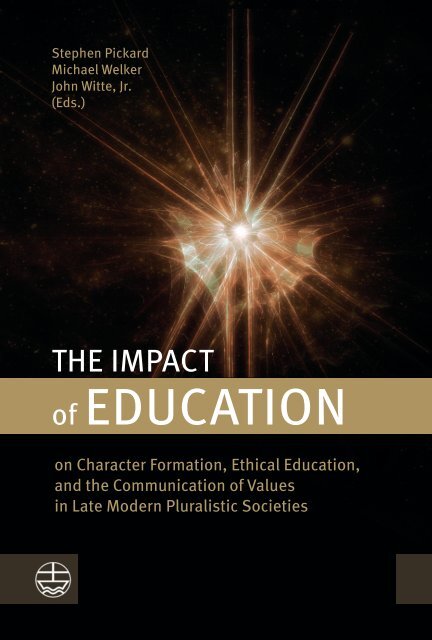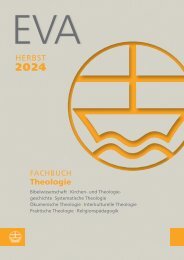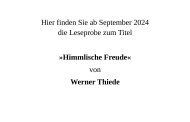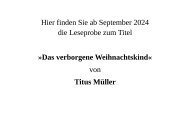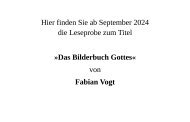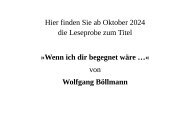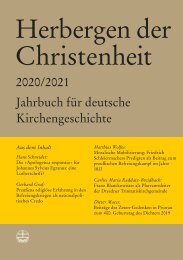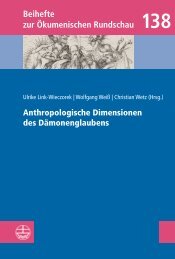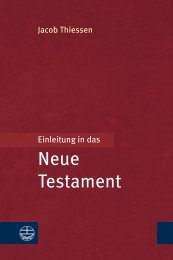Stephen Pickard | Michael Welker | John Witte (Eds.): The Impact of Education (Leseprobe)
This book investigates the impact of education on the formation of character, moral education and the communication of values in late modern pluralistic societies. Scholars from four continents and many different academic fields are involved. While the basic framework for the contributions is informed by Christian traditions, the disciplines cover a significant range, including theology, education, psychology, literature, anthropology, law, and business. This makes for a rich variety of thematic concentrations and perspectives. Readers will quickly sense that the educational foundations and trajectories of any given country are pervasive and have a significant reach into the fabric and shape of the society and its values, making education a barometer of the well-being of a people and their culture. The result is a volume that will inform, stimulate and challenge our understanding of the role of education in contemporary societies.
This book investigates the impact of education on the formation of character, moral education and the communication of values in late modern pluralistic societies. Scholars from four continents and many different academic fields are involved. While the basic framework for the contributions is informed by Christian traditions, the disciplines cover a significant range, including theology, education, psychology, literature, anthropology, law, and business. This makes for a rich variety of thematic concentrations and perspectives. Readers will quickly sense that the educational foundations and trajectories of any given country are pervasive and have a significant reach into the fabric and shape of the society and its values, making education a barometer of the well-being of a people and their culture. The result is a volume that will inform, stimulate and challenge our understanding of the role of education in contemporary societies.
You also want an ePaper? Increase the reach of your titles
YUMPU automatically turns print PDFs into web optimized ePapers that Google loves.
<strong>Stephen</strong> <strong>Pickard</strong><br />
<strong>Michael</strong> <strong>Welker</strong><br />
<strong>John</strong> <strong>Witte</strong>, Jr.<br />
(<strong>Eds</strong>.)<br />
THE IMPACT<br />
<strong>of</strong> EDUCATION<br />
on Character Formation, Ethical <strong>Education</strong>,<br />
and the Communication <strong>of</strong> Values<br />
in Late Modern Pluralistic Societies
Inhalt<br />
Acknowledgements ...................................... 7<br />
Preface to the Series ...................................... 9<br />
<strong>Stephen</strong> <strong>Pickard</strong><br />
Introduction ............................................. 13<br />
Part One: Society, Values, and Character<br />
Anne W. Stewart<br />
What Has Solomon to Do with Google? Old Testament Wisdom<br />
Literature and the Mediation <strong>of</strong> Truth in Modern Pluralistic<br />
Societies ................................................ 25<br />
Robert W. Hefner<br />
Character Socialization and Diversity in Modern Democracies<br />
Today ................................................... 37<br />
Joachim Funke<br />
Character Formation from aPsychological Point <strong>of</strong> View:<br />
Search for Values, Search for Sinn .......................... 47<br />
Charles L. Glenn<br />
Civic Norms and Distinctive Convictions: Finding the Right<br />
Balance ................................................. 59<br />
Part Two: National Contexts<br />
<strong>John</strong> <strong>Witte</strong> Jr.<br />
Restoring the Value(s) <strong>of</strong> Religion in American Public <strong>Education</strong> 89<br />
Heike Springhart<br />
Stabilizing Continuity and Transforming Spirituality: Germany’s<br />
Democratization after 1945 asanExample <strong>of</strong> the <strong>Impact</strong> <strong>of</strong><br />
<strong>Education</strong> on Character Formation, the Communication <strong>of</strong><br />
Values, and the Breakdown <strong>of</strong> Totalitarianism ................ 107
6 Inhalt<br />
Jo-Anne Reid<br />
School <strong>Education</strong> in Australia: Building Character and<br />
Reforming the Nation ..................................... 123<br />
Chung-Hyun Baik<br />
An Analysis <strong>of</strong> the <strong>Impact</strong> <strong>of</strong> the Korean <strong>Education</strong> System on<br />
the Character, Ethics, and Values <strong>of</strong> Koreans and Its Implications<br />
for Late Modern Pluralistic Societies ........................ 147<br />
Ashley Berner<br />
Public <strong>Education</strong> and Moral Formation in the United States:<br />
AView from the Early Twenty-First Century .................. 155<br />
Part Three: Emerging <strong>The</strong>mes<br />
David S. Cunningham<br />
Vocational Exploration as Character Formation: ANew Direction<br />
for Higher <strong>Education</strong> ...................................... 173<br />
Irene Pieper<br />
Character Formation and Literarische Bildung: Aims and<br />
Potentials in Literature <strong>Education</strong> .......................... 187<br />
Darcia Narvaez<br />
Resetting Baselines for an Earth-Centered Moral <strong>Education</strong> .... 201<br />
Contributors ............................................. 215
Acknowledgements<br />
This volume was made possible byagenerous grant from the McDonald Agape<br />
Foundation. We give thanks to President Peter McDonald and the members <strong>of</strong> the<br />
Foundation board for their support. We are grateful to the University <strong>of</strong> Heidelberg<br />
and to our colleagues at the Forschungszentrum Internationale und Interdisziplinäre<br />
<strong>The</strong>ologie (FIIT) in Heidelberg. We also <strong>of</strong>fer thanks for the support and<br />
encouragement <strong>of</strong> colleagues in the Research Centre for Public and Contextual<br />
<strong>The</strong>ology atCharles Sturt University in Canberra. We give thanks for the work<br />
on this volume by Dr. Gary S. Hauk, senior editor in the Center for the Study <strong>of</strong><br />
Law and Religion at Emory University. It was aprivilege to learn from each <strong>of</strong> our<br />
chapter authors and to work with our editorial friendsatEvangelischen Verlagsanstalt<br />
in Leipzig. Warmest thanks to each <strong>of</strong> them for sharing theirtime and talents<br />
with us so generously.
Preface to the Series<br />
Five hundred years ago, Protestant reformer Martin Luther argued that “three<br />
estates” (drei Stände) lie at the foundation <strong>of</strong> ajust and orderly society – marital<br />
families, religious communities, and political authorities. Parents in the home;<br />
pastors in the church; magistrates in the state—these, said Luther, are the three<br />
authorities whom God appointed to represent divine justice and mercy in the<br />
world, to protect peace and liberty in earthly life. Household, church, and<br />
state—these are the three institutional pillars on which to build socialsystems <strong>of</strong><br />
education and schooling, charity and social welfare, economy and architecture,<br />
art and publication. Family, faith, and freedom—these are the three things that<br />
people will die for.<br />
In the half millennium sinceLuther, historians have uncovered various classical<br />
and Christian antecedents to these early Protestant views. And numerous<br />
later theorists have propounded all manner <strong>of</strong> variations and applications <strong>of</strong> this<br />
three-estates theory, many increasingly abstracted from Luther’s overtly Christian<br />
worldview. Early modern covenant theologians, both Christian and Jewish,<br />
describedthe marital, confessional, and political covenants that God calls human<br />
beings to form, each directed to interrelated personal and public ends. Social-contract<br />
theorists differentiated the three contracts that humans enter as they move<br />
from the state <strong>of</strong> nature to an organized societyprotective <strong>of</strong> their natural rights—<br />
the marital contract <strong>of</strong> husband and wife; the government contract <strong>of</strong> rulers and<br />
citizens;and, for some, the religious contracts<strong>of</strong>preachers and parishioners. Early<br />
anthropologists posited three stages <strong>of</strong> development <strong>of</strong> civilization—from family-basedtribes<br />
and clans, to priest-run theocracies, to fully organizedstates that<br />
embraced all three institutions. Sociologists distinguished three main forms <strong>of</strong><br />
authority in an organized community—“traditional” authority that begins inthe<br />
home, “charismatic” authority that is exemplified by the church, and “legal” authority<br />
that is rooted in the state. Legal historians outlined threestages <strong>of</strong> development<br />
<strong>of</strong> legal norms—from the habits and rules <strong>of</strong> the family, to the customs and<br />
canons <strong>of</strong> religion, to the statutes and codes <strong>of</strong> the state.
10 Preface to the Series<br />
Already acentury ago, however, scholars in different fields began to flatten out<br />
this hierarchical theory <strong>of</strong> social institutions and to emphasize the foundational<br />
role <strong>of</strong> other social institutions alongside the family, church, and state in shaping<br />
private and public life and character. Sociologistslike Max Weber and Talcott Parsons<br />
emphasized the shaping powers <strong>of</strong> “technical rationality” exemplified especially<br />
in new industry, scientific education, and market economies.Legal scholars<br />
like Otto von Gierkeand F. W. Maitland emphasized the criticalroles <strong>of</strong> nonstate<br />
legal associations (Genossenschaften) inmaintaining ajust social, political, and<br />
legal order historically and today.Catholic subsidiarity theories <strong>of</strong> Popes Leo XIII<br />
and Pius XI emphasized the essentialtask <strong>of</strong> mediating social units between the<br />
individual and the state to cater the full range <strong>of</strong> needs, interests, rights, and duties<br />
<strong>of</strong> individuals. Protestant theories <strong>of</strong> sphere sovereignty, inspired by Abraham<br />
Kuyper, argued that not only churches, states,and families but also the social<br />
spheres <strong>of</strong> art, labor, education, economics, agriculture, recreation, and more<br />
should enjoy alevel <strong>of</strong> independence from others, especially an overreaching<br />
church or state. Various theories <strong>of</strong> social or structural pluralism, civil society,<br />
voluntary associations, the independent sector, multiculturalism, multinormativity,<br />
and other such labels have now come to the fore in the ensuing decades<br />
—both liberal and conservative, religious and secular, and featuring all manner<br />
<strong>of</strong> methods and logics.<br />
Pluralism <strong>of</strong> all sorts is now acommonplace <strong>of</strong> late modern societies. At minimum,<br />
this means amultitude <strong>of</strong> free and equal individuals and amultitude <strong>of</strong><br />
groups and institutions, each with very different political, moral, religious, and<br />
pr<strong>of</strong>essional interests and orientations. It includes the sundry associations, interest<br />
groups, parties, lobbies, and social movements that <strong>of</strong>ten rapidly flourishand<br />
fade around acommon cause, especially when aided by modern technology and<br />
various social media. Some see in this texture <strong>of</strong> plurality an enormous potential<br />
for colorful and creative development and arobust expression <strong>of</strong> human and cultural<br />
freedom. Others see achaotic individualism and radical relativism, which<br />
endangers normative education, moral character formation, and effective cultivation<br />
<strong>of</strong> enduring values or virtues.<br />
Pluralism viewed as vague plurality, however, focuses on only one aspect <strong>of</strong><br />
late modern societies—the equality <strong>of</strong> individuals, and their almost unlimited freedom<br />
to participate peaceablyatany time as arespected voice in the moral reasoning<br />
and civil interactions <strong>of</strong> asociety. But this view does not adequately recognize<br />
that, beneath the shifting cacophony <strong>of</strong> social forms and norms that constitute<br />
modernity, pluralistic societies have heavy normative codes that shape their individual<br />
and collective values and morals, preferences and prejudices.<br />
<strong>The</strong> sources <strong>of</strong> much <strong>of</strong> this normative coding and moral education in late<br />
modern pluralistic societies are the deep and powerful socialsystems that are the<br />
pillars <strong>of</strong> every advanced culture. <strong>The</strong> most powerful and pervasive <strong>of</strong> these are<br />
the social systems <strong>of</strong> law, religion, politics, science/academy, market, media, fam-
Preface to the Series 11<br />
ily, education, medicine, and national defense. <strong>The</strong> actual empirical forms <strong>of</strong> each<br />
<strong>of</strong> these powerful social systems can and do vary greatly, even inthe relatively<br />
homogeneous societies <strong>of</strong> the late modern West. But these deeper socialsystems<br />
in one form or another are structurally essential and <strong>of</strong>ten normatively decisive in<br />
individual and communal lives.<br />
Every advanced society has acomprehensive legal system <strong>of</strong> justice and order,<br />
religious systems <strong>of</strong> ritual and doctrine, afamily system <strong>of</strong> procreation and<br />
love, an economic system <strong>of</strong> trade and value, amedia system <strong>of</strong> communication<br />
and dissemination <strong>of</strong> news and information, and an educational system <strong>of</strong>preservation,<br />
application, and creation <strong>of</strong> knowledge and scientific advance. Many<br />
advanced societies also have massive systems <strong>of</strong> science, technology, health care,<br />
and national defense with vast influence over and through all <strong>of</strong> these other social<br />
systems. <strong>The</strong>se pervasive social systems lie at the foundation <strong>of</strong> modern advanced<br />
societies, and they anchor the vast pluralities <strong>of</strong> associations and social interactions<br />
that might happen to exist at any given time.<br />
Each <strong>of</strong> these social systems has internal value systems, institutionalized rationalities,<br />
and normative expectations that together help to shape each individual’smorality<br />
and character. Each <strong>of</strong> these social spheres, moreover, has its own<br />
pr<strong>of</strong>essionals and experts who shape and implement its internal structures and<br />
processes. <strong>The</strong> normative network created by these socialspheres is <strong>of</strong>ten harder<br />
to grasp today, since late modern pluralistic societies usually do not bring these<br />
different value systems to light under the dominance <strong>of</strong> just one organization, institution,and<br />
power. And this normative network has also become more shifting<br />
and fragile, especially since traditional social systems like religion and the family<br />
have eroded in theirdurabilityand power, and other social systems like science,<br />
the market, health care, defense, and the media have become more powerful.<br />
<strong>The</strong> aim <strong>of</strong> this multiyear project on “Character Formation and Moral <strong>Education</strong><br />
in Late Modern Pluralistic Societies” is to identifythe realities and potentials<br />
<strong>of</strong> these core socialsystems to provide moral orientation and characterformation<br />
in our day. What can and should these social spheres, separatelyand together, do<br />
in shaping the moral character <strong>of</strong> late modern individuals who, by nature, culture,<br />
and constitutional norms, are free and equalindignity and rights?What are and<br />
should be the core educational functions and moral responsibilities <strong>of</strong> each <strong>of</strong><br />
these socialspheres?How can we better understand and better influence the complex<br />
interactions among individualism, the normative binding powers <strong>of</strong> these<br />
social systems, and the creativity <strong>of</strong> civil groups and institutions? How can we<br />
map and measure the different hierarchies <strong>of</strong> values that govern each <strong>of</strong> these<br />
social systems, and that are also interwoven and interconnected in various ways<br />
in shaping late modern understandings <strong>of</strong> the common good? How do we negotiate<br />
the boundaries and conflicts between and among these social systems when<br />
one encroaches on the other, or imposesits values and rationalities on individuals<br />
at the cost <strong>of</strong> the other social spheres or <strong>of</strong> the common good?What and where are
12 Preface to the Series<br />
the intrinsic strengths <strong>of</strong> each social sphere that should be made more overt in<br />
character formation, public education, and the shaping<strong>of</strong>minds and mentalities?<br />
<strong>The</strong>se are some <strong>of</strong> the guiding questions at work in this project and in this<br />
volume. Our project aims to provide asystematicaccount <strong>of</strong> the role <strong>of</strong> these powerful<br />
normativecodesoperating in the socialspheres<strong>of</strong>law, religion, the family,<br />
the market, the media, science and technology, the academy, health care, and defense<br />
in the late modern liberal West. Our focus is on selected examples and case<br />
studies drawnfrom Western Europe, North America, South Africa, and Australia,<br />
which together provide just enough diversity to test out broader theories <strong>of</strong> character<br />
formation and moral education. Our scholars are drawn from across the<br />
academy, with representative voices from the humanities, social sciences, and<br />
natural sciences as well as the pr<strong>of</strong>essions <strong>of</strong> theology, law, business, medicine,<br />
and more. While most <strong>of</strong> our scholars come from the Protestant and Catholic<br />
worlds, our endeavor is to <strong>of</strong>fer comparative insights that will help scholars from<br />
any pr<strong>of</strong>ession or confession. While our laboratory is principally Western liberal<br />
societies, the modern forces <strong>of</strong> globalizationwill soon make these issues <strong>of</strong> moral<br />
character formation aconcern for every cultureand region <strong>of</strong> the world—given the<br />
power <strong>of</strong> global social media, entertainment, and sports; the pervasiveness <strong>of</strong><br />
global finance, business, trade, and law; and the perennial global worries over<br />
food, health care, environmental degradation, and natural disasters.<br />
This volume is focused on the impact <strong>of</strong> education on character formation,<br />
ethics, and the communication <strong>of</strong> values in late modern pluralistic societies. It<br />
builds on four volumes already in print on the respective impacts <strong>of</strong> the market,<br />
religion, law, and academic research, and these will soon have acompanion volume<br />
on the impact <strong>of</strong> the family. Forthcoming volumes will study the respective<br />
impacts <strong>of</strong> the media, the military/defense system, politics, and health-care<br />
systems. Afinal integrative monograph will distill the main findings <strong>of</strong> these<br />
volumes and outline some constructive responses for late modern pluralistic<br />
societies.<br />
<strong>Michael</strong> <strong>Welker</strong>, University <strong>of</strong> Heidelberg<br />
<strong>John</strong> <strong>Witte</strong> Jr., Emory University<br />
<strong>Stephen</strong> <strong>Pickard</strong>, Charles Sturt University
Introduction<br />
<strong>Stephen</strong> <strong>Pickard</strong><br />
This book investigates the impact <strong>of</strong> education on the formation <strong>of</strong> character and<br />
the communication <strong>of</strong> values in late modern pluralistic societies. Scholars from<br />
four continents and many different academic fields are involved. While the basic<br />
framework for the contributions is informed by Christian traditions, the disciplines<br />
cover asignificant range, including theology, education, psychology, literature,<br />
anthropology, law, and business. This makes for arich variety <strong>of</strong> thematic<br />
concentrations and perspectives.<br />
While the perspectives and content <strong>of</strong> the chapters are diverse, anumber <strong>of</strong><br />
themescontinuallyreemerge. First, the authors, perhaps unsurprisingly but none<br />
the less importantly, all give voice to the significance <strong>of</strong> education inits many<br />
forms and contexts as amajor contributor to the formation <strong>of</strong>character and the<br />
communication <strong>of</strong> values in late modern pluralistic societies. <strong>The</strong> educational<br />
foundations and trajectories <strong>of</strong> any given country are pervasive and have asignificant<br />
reach into the fabric and shape <strong>of</strong> the societyand its values, making education<br />
abarometer <strong>of</strong> the well-being <strong>of</strong> apeople and their culture(s). Thus, avolume<br />
on the impact <strong>of</strong> education is an important addition to this series.<br />
Second, the contributions to this volume point to the contested nature <strong>of</strong> the<br />
role and purpose <strong>of</strong> education in the formation <strong>of</strong> character and shaping <strong>of</strong> values<br />
in different contexts. What continuallyemerges in the essaysinthis volume is a<br />
recognition <strong>of</strong> the influence <strong>of</strong> otherinterests and concernsonpolicies, programs,<br />
and delivery <strong>of</strong> education. Whether it is the nexus between education and politics,<br />
economics and work, or national identity and history, in all these areas and more,<br />
the formation <strong>of</strong> character and values through education is never simple,always<br />
inherently fragile, and ever in need <strong>of</strong> vigilance. In short, it is not agiven that<br />
education as such can fulfill its purpose as acommunicator <strong>of</strong> values and moral<br />
vision for the common good.<br />
Third, the essays inthis volume highlight the remarkable potential <strong>of</strong> informed<br />
educational philosophy and policies to foster an environment conducive<br />
to forming character and contributing to cultures that value respect, care, and creativity.<br />
In this respect, the final three chapters <strong>of</strong> this volume are <strong>of</strong> particular
14 <strong>Stephen</strong> <strong>Pickard</strong><br />
note, as they address issues concerning vocation and discernment, the importance<br />
<strong>of</strong> literature, and the call for aradical rethinking <strong>of</strong> moral education and<br />
practice from the perspective <strong>of</strong> Indigenous and planetary concerns.<br />
<strong>The</strong> book is divided into three parts covering (a) general issues concerning<br />
education with respect to society, values, and character; (b) issues for education<br />
and character formation arising from different national contexts; and (c) emergent<br />
themesrelevant to the contribution <strong>of</strong> education to forming character and values.<br />
Part One, on Society, Values, and Character, begins with achapter by Anne<br />
Stewart, (“What Has Solomon to Do with Google? Old Testament Wisdom Literature<br />
and the Mediation <strong>of</strong> Truth in Modern Pluralistic Societies”). Stewart examines<br />
the book <strong>of</strong> Proverbs as awisdomsystem for truth discernment. She argues<br />
that such ahistorical perspective on competing truth claims might have something<br />
important to teach our contemporary society, caught as it is in a “contest<br />
<strong>of</strong> information” and “infodemic” related to the spread <strong>of</strong> misinformation. What<br />
is required above all else is discernment among competing voices and truths. This<br />
is atimeless human dynamic, albeit madeeven more challenging by modern media<br />
and technology. In short, does Google have the last word, or is there yet an<br />
ancient wisdom to fill the void?<br />
Stewart points out that the book <strong>of</strong> Proverbs says more about character and<br />
the gaining <strong>of</strong> wisdom than any other literature <strong>of</strong> the Bible. It is an instruction<br />
manual for wise living and, as such, abook about education. This includes the<br />
young and the old, the neophyteand the sage. Proverbs conveys asense <strong>of</strong> urgency,<br />
for it has to do with attaining “skills to navigate the world.” Nor is the book <strong>of</strong><br />
Proverbs naïve about the complexities <strong>of</strong> discernment in the moral world; the<br />
book’s “aim is to foster wise character in its students, equipping them for living<br />
amid the grey hues <strong>of</strong> moral discernment.” In this sense, the book invites “contextual<br />
ethical reflection” amid the puzzles and contradictions <strong>of</strong> life. Stewart is<br />
thus clear about the relevance <strong>of</strong> the book for “the formation <strong>of</strong> wise character in a<br />
context <strong>of</strong> competing perspectives, truth claims, and moral worldviews.” It is apparent<br />
from aclose reading <strong>of</strong> Proverbs that we have to do with the “education <strong>of</strong><br />
desire.”<br />
Stewart’s discussion <strong>of</strong> the competing voices <strong>of</strong> “woman Wisdom” and<br />
“strange woman” pierces our contemporary experience <strong>of</strong> the strange and alluring<br />
algorithms <strong>of</strong> Google and Facebook, with their inbuilt monetizing <strong>of</strong>desire,<br />
ambiguous treatment <strong>of</strong> information, and tendency to generate division and new<br />
tribal networks. Acareful reading <strong>of</strong> Proverbs draws attention to the fact that a<br />
contest <strong>of</strong> truth is at the same time atest <strong>of</strong> character for asociety.<br />
Robert Hefner (“Character Socialization and Diversity in Modern Democracies<br />
Today”)presses two questionsthat require precisely the kind <strong>of</strong> wise discernment<br />
that Stewart seeks. He asks: What kind <strong>of</strong> character education is appropriate<br />
for the societies and polities in which we moderns live? And what conditions in<br />
society either facilitate or impede the realization <strong>of</strong> this form <strong>of</strong> character educa-
Introduction 15<br />
tion and, with it, its ability to influence understandings<strong>of</strong>the public good?Hefner<br />
argues that “efforts to build sustainable consensus on both character education<br />
and citizenship” havebeen hampered by both aradical ethical-religious plurality<br />
and what he refers to as “the rise <strong>of</strong> new forms <strong>of</strong> social mediation and mobilization,”<br />
which undermine consensus and generate ethical and social differences for<br />
commercial and political purposes. Hefner draws upon the discussions<strong>of</strong>Charles<br />
Taylor and <strong>John</strong> Rawls on the subject <strong>of</strong> “overlapping consensus,” which is critical<br />
“for civic coexistence and the public good.” Hefner argues that, notwithstanding<br />
serious negative social and ethical consequences for minorities, key features <strong>of</strong><br />
Christianity have contributed “to the inculcation <strong>of</strong> genuinely civil habits <strong>of</strong> the<br />
heart, as well as providing theological and ontological grounds forthe affirmation<br />
<strong>of</strong> human dignity.” <strong>The</strong> distortions that arise, in Hefner’s view, are due to “political<br />
entrepreneurs” in civil society who harness popular Christian identities to<br />
override the dignity-affirming message <strong>of</strong> the Christian gospel. Political instrumentalization<br />
trumps theological depth. Hefner also highlights the way the Janus-faced<br />
capacity for religious socialization can generate exclusive rather than<br />
inclusivepublic ends (as in, forexample, France and India). He points out the importance<br />
<strong>of</strong> commitment to the modern values <strong>of</strong> democratic civility and <strong>of</strong>fers us<br />
cogent and urgent reasons to protect our civic and religious education.<br />
Joachim Funke’schapter (“Character Formation from aPsychological Point <strong>of</strong><br />
View: Search for Values, Search for Sinn”)examines psychological studies <strong>of</strong> character<br />
formation and values. <strong>The</strong> emphasis is on the dynamics<strong>of</strong>development over<br />
the course <strong>of</strong> ahuman lifespan.This approach, which has been the standard paradigm<br />
since the mid-twentieth century, asks about the origins and development <strong>of</strong><br />
moral values and how they might change. Funke introduces the reader to two different<br />
approaches in psychology to the question <strong>of</strong> character:anarrow one, which<br />
associates character with moral attitudes that develop over time like other “faculties,”<br />
such as cognition, emotion, and language (Jean Piaget and Lawrence Kohlberg);<br />
and abroader one, which connects character formation to personality development<br />
that involves both stable personal traits and variable states across<br />
situations. <strong>The</strong> latter approach <strong>of</strong>fers greater possibilities for change over time,<br />
and education seems to provide the optimum conditions for such change.<br />
Whether or not wisdom might be the result<strong>of</strong>successful character formation<br />
is amootpoint. Perhaps characterand moral values can be measured.This is an<br />
area in which psychologists invest considerable expertise. But what to do with<br />
this information, and what insightdoes it yield for character formation?Another<br />
tack involves experimental research in moral dilemmas, though Funke is wary <strong>of</strong><br />
drawing too much by way <strong>of</strong> conclusions from such experiments for understanding<br />
characterformation. In short, it seems that character formationisacomplex<br />
process that is not particularly accessible by psychological measurement. It<br />
seems that the human search for values and Sinn (making sense <strong>of</strong> things) is what<br />
makes us human and not robots.
16 <strong>Stephen</strong> <strong>Pickard</strong><br />
If, as Funke’s psychological assessment suggests, character formation and<br />
moral disposition are fundamentally matters <strong>of</strong> individual development in society,<br />
then it begs aquestion: Where, and with whom, does responsibility lie for<br />
fostering civic skills and virtues? This question is taken up by Charles Glenn<br />
(“Civic Norms and Distinctive Convictions: Finding the Right Balance”). Specifically,<br />
Glenn examines the contribution to character formationbynongovernmental<br />
schools undergirded by distinctive religious convictions. This matter is clearly<br />
controversial, as opponents argue that these kinds <strong>of</strong> schools constitute athreat to<br />
public education’smission “to develop citizens possessing the appropriate dispositions<br />
to sustain awell-functioning society.” Shared convictions and loyalties<br />
that inculcate civic virtues conducive to social and political peace apparently require<br />
the banishment <strong>of</strong> distinctive religious beliefs and convictions <strong>of</strong> families<br />
and communities from the educational process. Underlying this view is what<br />
Glenn identifies as the “myth <strong>of</strong> the common school,” associated with the idea <strong>of</strong><br />
nation formingand social unity via popular schooling. Glenn <strong>of</strong>fers an insightful<br />
commentary on the history <strong>of</strong> this issue, citing Michel Foucault’s view that the<br />
“state has taken over from the medievalchurch the role and the techniques <strong>of</strong> the<br />
‘cure <strong>of</strong> souls,’ with pretensions extending well beyond its traditional duties<strong>of</strong>the<br />
maintenance <strong>of</strong> domestic tranquility and the administration <strong>of</strong> justice.”<br />
Glenn’sessay highlightsmany important issues regarding the role <strong>of</strong> education<br />
for citizenship, the role <strong>of</strong> governments in such processes, and the dangers <strong>of</strong><br />
politicizing children’s education in ways that thwart the needs <strong>of</strong>children for a<br />
culturally coherent life. He raises fundamental questions about how civic virtue<br />
might be developed, and by whom. In the challenging, <strong>of</strong>ten fragmenting and<br />
highly polarized times in which we live, Glenn sees acritical role for the “vitality<br />
<strong>of</strong> faith-based institutions, including schools, where trust is based upon shared<br />
commitments [and] is aprecious resource to society at large.”<br />
Part Two, National Contexts, explores the impact <strong>of</strong> education on character<br />
and moral education in Germany, Australia, South Korea, and the United States.<br />
Heike Springhart (“Stabilizing Continuity and Transforming Spirituality: Germany’s<br />
Democratization after 1945 asanExample <strong>of</strong> the <strong>Impact</strong> <strong>of</strong> <strong>Education</strong> on<br />
CharacterFormation, the Communication<strong>of</strong>Values, and the Breakdown <strong>of</strong> Totalitarianism”)isconcerned<br />
with the potential <strong>of</strong> religion to contribute to atruly democratic<br />
way <strong>of</strong> life. She examines aspects <strong>of</strong> Germany’s democratization after<br />
1945 in so far as they highlight the role <strong>of</strong> education in shaping the character<br />
and values <strong>of</strong> anation in atime <strong>of</strong> significant transition. In doing so, Springhart<br />
identifies various themes—for example, reeducation as apedagogic program; reeducation<br />
as part <strong>of</strong> the process <strong>of</strong> comprehensive democratization; and the importance<br />
<strong>of</strong> harnessing “clear areas” (relatively healthyspheres) <strong>of</strong> societyaslocations<br />
for reeducation.<br />
With respect to this last theme, studies appear to have overlooked the<br />
significance <strong>of</strong> religion and the churches as places <strong>of</strong> resistance and, hence, “clear
Introduction 17<br />
areas.” Springhart focuses on how religion and the churches played avital role in<br />
the reeducation process, which was strongly influenced by therapeutic models <strong>of</strong><br />
recovery from social and cultural psychosis. <strong>The</strong>re is aplace here for an educational<br />
therapeuticdesigned to shape and strengthen character at both the individual<br />
and the national level. Important in this respect is Talcott Parsons’sconcept<strong>of</strong><br />
“controlled institutional change,” which included aform <strong>of</strong> religion to help shape<br />
afree, democratic societyand act as acritical counterpart to the impact <strong>of</strong> National<br />
Socialism.<strong>The</strong> premise was simple:democracy was primarilyaway <strong>of</strong> life, and<br />
healthy social institutions provided avital component in the process <strong>of</strong> reeducation<br />
and characterformation. Springhartshows the extensive international cooperation<br />
and sharedlearning entailed in the reeducation process; draws attention<br />
to the significance <strong>of</strong> and continuingimpact <strong>of</strong> Protestant Academiesinpostwar<br />
Germany as sources <strong>of</strong> moral and spiritual support; highlightsthe role <strong>of</strong> women<br />
in the educative and political process in anew German society; and recalls the<br />
significance <strong>of</strong> church-based welfare organizations. Importantly, Springhart underscores<br />
the importance <strong>of</strong> religion in tempering the alienating aspects <strong>of</strong><br />
change and keeping alive in society questions <strong>of</strong>meaning and purpose. Overall,<br />
we are leftwith the two complementary ecclesial and theological impulses in the<br />
process <strong>of</strong> educationfor ademocratic way <strong>of</strong> life: stabilizing continuity and transforming<br />
spirituality.<br />
Jo-Anne Reid (“School <strong>Education</strong> in Australia: Building Character and Reforming<br />
the Nation”) focuses on the role <strong>of</strong> school education asameans for reforming<br />
national character. <strong>The</strong> background is the continuing tension between<br />
asystemicracism that emerged from Anglo-Saxon colonization in the late eighteenth<br />
century and the fact that Australia is one <strong>of</strong> the most culturally and linguistically<br />
diverse societies in the world. Reid argues that “the challenge <strong>of</strong> shaping a<br />
population that will continue to uphold the values <strong>of</strong> apluralistsociety is largely<br />
entrusted to the education system, through its national ‘civics and citizenship’<br />
curriculum.” Given the diversity <strong>of</strong> cultures, races, languages, and values “schooling<br />
may well be the only sharedsocial institution that young people participate in<br />
prior to exercising their rights as citizens.”<br />
This is atall order for any education system. It is made even more problematic<br />
because Australian educationstillreflects aset <strong>of</strong> Christianvalues contaminated<br />
by desires for wealth and status, founded on the “convenient lie <strong>of</strong> Australia as<br />
terra nullius,” which has been responsible for the emergence <strong>of</strong> avariety <strong>of</strong> discriminatory<br />
and undemocratic social outcomes. As aconsequence, amajor task<br />
for Australian education is to engage with a “decolonializing curriculum for educating<br />
the next generation <strong>of</strong> young Australians.” How well or otherwise this task<br />
is undertaken will determine the kind <strong>of</strong> society—its character and values—that<br />
coming generations will inherit and live by. Reid highlights the differences between<br />
educationwithin the framework <strong>of</strong> an essentially British school system and<br />
the broader European notions <strong>of</strong> character building as asocial and cultural sub-
18 <strong>Stephen</strong> <strong>Pickard</strong><br />
ject. As Reid makes clear, such aprocess needs to begin in the earliest years <strong>of</strong> a<br />
child’s education.<br />
<strong>John</strong> <strong>Witte</strong> Jr. (“Restoring the Value(s) <strong>of</strong> ReligioninAmerican Public <strong>Education</strong>”)draws<br />
attention to the easily overlooked fact that the school’sinfluence on<br />
character formation is more overt and visible than the more subtle but powerful<br />
influences <strong>of</strong> other major societal systems, such as markets, laws, politics, the<br />
media, and so on. His focus is on “the prominent role <strong>of</strong> modern American<br />
state-run public schools in educatingmodern citizens and the deprecated role <strong>of</strong><br />
religion in the delivery <strong>of</strong> this public education.” <strong>Witte</strong> comments on the role <strong>of</strong><br />
the courts in this latter development and the resultant impoverishment <strong>of</strong> “the<br />
values education and character formation <strong>of</strong> American students in primary and<br />
secondary public schools, and sometimes in public universities, too.” <strong>The</strong> consequences<strong>of</strong>this<br />
diminished place <strong>of</strong> religion in education have been pr<strong>of</strong>oundwith<br />
regard to students’ appreciating their own religious beliefs and practicesinrelation<br />
to those <strong>of</strong> others and promoting the false idea that religion is essentially a<br />
matter <strong>of</strong> private disposition. This loss is particularly serious given the massive<br />
industry that educationand schoolingare in the United States, and it constitutes<br />
“amajor battleground for constitutional struggles over religious freedom.” <strong>Witte</strong><br />
tracks some <strong>of</strong> the legal disputes in which religion was pushed further to the margins<br />
<strong>of</strong> public education, and he highlights more recent attempts in the courts to<br />
challenge this marginalization on the basis <strong>of</strong> free speech, freedom <strong>of</strong> religion,<br />
and equal access. Prominentinthese battles are critics who argue for the inherent<br />
usefulness <strong>of</strong>religious values in helping to shape the character and outlook <strong>of</strong><br />
young people preparing to take their place in an open and democratic society.<br />
<strong>Witte</strong> notes the global resurgence and power <strong>of</strong> religion, for good and ill.<br />
Public-school education ought not ignore this. <strong>Witte</strong> provides apowerful critique<br />
and assessment <strong>of</strong> public education in the context <strong>of</strong>current American<br />
society and politics.<br />
Chung-Hyun Baik (“An Analysis <strong>of</strong> the <strong>Impact</strong>s <strong>of</strong> the Korean <strong>Education</strong> System<br />
on the Character, Ethics, and Values <strong>of</strong> Koreansand Its Implications for Late<br />
Modern Pluralistic Societies”)<strong>of</strong>fers an Asian perspective as aSouth Korean theologian.<br />
Baik comments on the challengesfacing acountry that places high value<br />
on student performance and achievement (particularly in reading, science, and<br />
mathematics) yet also registers ahigh level <strong>of</strong> student anxiety and unhappiness<br />
in the educational process. What are the origins <strong>of</strong> this tension? What are its implications<br />
for the role <strong>of</strong> education in character development? And, importantly,<br />
what correctives are required?<br />
Baik traces the origins <strong>of</strong> this tension in the history <strong>of</strong> the Korean education<br />
system, noting the earlypurpose <strong>of</strong> education in the training <strong>of</strong> children from ruling<br />
aristocratic families to become government <strong>of</strong>ficials; later reforms that<br />
opened education beyond those from the ruling classes; the further impact <strong>of</strong> Japanese<br />
annexation <strong>of</strong> Korea, with the result that the Korean education system be-
Introduction 19<br />
came subjugated to Japanese imperialism; and post-World War IIreforms that<br />
nonetheless remained highly politicized, with afocus on anticommunism and an<br />
emphasis on education for industrial and economic development.<br />
One consequence <strong>of</strong> the educational-political link is that the Korean education<br />
system is “grounded in meritocracy” based on abilities rather than money<br />
or social status. <strong>The</strong> top priority is for students to serve the purposes <strong>of</strong> governmental<br />
rule, whose achievement is regarded as asign <strong>of</strong> not only individual success<br />
but also filial duty to one’sparents and family. <strong>The</strong> roots <strong>of</strong> anxietyare thus<br />
sown out <strong>of</strong> aparticular cultural history that prizes both responsible leadership in<br />
society and afamily centrism and egoistic familism. This culture <strong>of</strong>success and<br />
competition is somewhat at odds with some <strong>of</strong> the centraltenets <strong>of</strong> Confucianism<br />
that encourage loving relations between people and overcoming oneself and governing<br />
others well. What this meansisthat educationfor the purpose <strong>of</strong> character<br />
development and values has adiminished role in the culture. With increasing cultural<br />
and social pluralism, change is taking place. <strong>Education</strong>for education’ssake,<br />
as well as its role in shaping character and values for individualsand society, represent<br />
achallenge to more entrenched political and historical agendas.<br />
Ashley Berner (“Public <strong>Education</strong> and Moral Formation in the United States:<br />
AView from the Early Twenty-First Century”) examines the development <strong>of</strong> the<br />
uniform model for Americanpublic education and makesastrong case for an alternative<br />
plurality model. Her work has resonances with the <strong>of</strong>ferings <strong>of</strong> Glenn<br />
and <strong>Witte</strong>inthis volume. Berner makes an important and <strong>of</strong>ten ignored point that<br />
“schools are inherently meaning-making institutions; every component <strong>of</strong> a<br />
school’s structure and content iseducative for students. Even the omissions—<br />
what is unacceptable to discuss—are instructive.” Given this reality, the pervasiveness<br />
and influence <strong>of</strong> the uniform model <strong>of</strong> state control <strong>of</strong> public educationinthe<br />
United States has proven to be farmore problematic than might have been either<br />
intended or imagined. Berner traces the emergence <strong>of</strong> the uniform model as an<br />
anxiety-driven response to threats to Protestant hegemony from increased pluralism<br />
and diversity. Such uniformity did not imply moral neutrality but rather “reinforced<br />
Protestant hegemony,” although this hegemony lost considerable force<br />
from the mid-twentieth century as courts (as outlined by <strong>John</strong> <strong>Witte</strong> in this volume)<br />
increasingly moved the country to amore secular model and marginalized<br />
the distinctly religious framework <strong>of</strong> public education. While the past quarter <strong>of</strong><br />
acentury has been marked by increasing diversity and plurality in public education,<br />
for the most part the system is captive to the common-school or uniform<br />
model.<br />
However,asBerner makes clear, the intent <strong>of</strong> the uniform model in its secular<br />
guise is to inculcate “moral and civic cohesion” across adiverse population. This<br />
kind <strong>of</strong> “civic republicanism” begs the question <strong>of</strong> which intellectual resources<br />
and institutional practices could be broadly acceptable within aheterogeneous<br />
society. She notes the lengths to which educators will go to foreclose discussion
20 <strong>Stephen</strong> <strong>Pickard</strong><br />
<strong>of</strong> fundamental questions concerning values, meaning, and the religious significance<br />
<strong>of</strong> hotly debated ethical issues. <strong>The</strong> default is to akind <strong>of</strong> majority viewpoint<br />
associated with what Berner terms a “moral therapeutic deism” and “expressive<br />
individualism.” What has happened to questions <strong>of</strong> character formation and moral<br />
vision for individuals and aculture?Can apluralist model <strong>of</strong> public education<br />
gain sufficient traction in the system?Not surprisingly, moral formationremains<br />
both contested and controversial.<br />
Part Three, Emerging <strong>The</strong>mes, sets out on adifferent tack to focus on some<br />
areas <strong>of</strong> emerging and contemporary concern. David Cunningham (“Vocational<br />
Exploration as Character Formation: ANew Direction for Higher <strong>Education</strong>”)<br />
shows how questions that broadly concern vocation are beginning to play amore<br />
important role for emerging generations <strong>of</strong> students in North America and elsewhere.<br />
“Students seem to be spending more time thinking about their personal<br />
strengths and weaknesses, pondering what will make for ameaningful or purposeful<br />
life, and sometimes even using the language <strong>of</strong> vocation or calling in their<br />
efforts to describe wheretheir livesmight be headed.” While this vocational turn<br />
is only in its infancy, Cunningham (and he is certainly not alone in this) judges<br />
this development to be aportent <strong>of</strong> apreoccupation that will have much wider and<br />
more significant implications for the way educative processes contribute to a<br />
broader approach to moral formation and civic and social engagements for the<br />
common good.<br />
How, then, does reflection on vocation (with its attendant concerns for meaning<br />
and purpose) connect with the matter <strong>of</strong> character formation?Cunningham’s<br />
chapter <strong>of</strong>fers an insightful examination <strong>of</strong> the contexts and features <strong>of</strong> ethics and<br />
character formationinhigher education in North America. Given the two tracks in<br />
higher education in that context—(a) public secular universities that usually steer<br />
clear <strong>of</strong> religious or quasi-religious matters and (b) private institutions that <strong>of</strong>ten<br />
have areligious foundation—it is not surprising that the latter institutions are<br />
most associated with acertain ethical freedom to pursue matters relevanttomoral<br />
education, character formation, and vocation. This ancient term (“vocation”)was<br />
reinterpreted by Luther during the Reformation beyond anarrow medieval clericalism<br />
to embrace abroad range <strong>of</strong> human occupations that includes one’swork<br />
but also domains that are deeply formative <strong>of</strong> away <strong>of</strong> life and asense <strong>of</strong> purpose.<br />
This richer concept <strong>of</strong> vocation is being taken up in places <strong>of</strong> higher education to<br />
enable students to explore matters <strong>of</strong> calling and discernment so that they might<br />
live purposefully. In other words, it’s not just about their prospective work, but<br />
involves moral education and character formation. Cunningham shows how this<br />
approach has consequences for personal and community commitments; the cultivation<br />
and integration <strong>of</strong> virtues into career, family, civic life, and leisure; and<br />
dealing with experiences <strong>of</strong> limit and finitude in aworld <strong>of</strong> myriad choices. All <strong>of</strong><br />
this is gristfor the mill <strong>of</strong> moral development and contribution to the greatergood
Introduction 21<br />
<strong>of</strong> society. This turn to vocation as akind <strong>of</strong> educational experiment has great potential<br />
for export into other national contexts.<br />
Irene Pieper (“CharacterFormation and Literarische Bildung: Aims and Potentials<br />
in Literature <strong>Education</strong>”)examines the potential <strong>of</strong> literature as asource and<br />
mediator <strong>of</strong> the educational process and its contribution to character formation<br />
and moral development. Pieper’s discussion is grounded in the notion <strong>of</strong> subjectivation—a<br />
relational process in asociological environment. This process is operative<br />
in the teacher-learner context, where readers encounter texts and learning<br />
takes place through co-construction.Pieperfinds that the potential <strong>of</strong> literature to<br />
stimulate personal development requires an “environment allowing for co-construction,<br />
particularly via communication,” which may be provided by family but<br />
certainly by formal education at school. In such an environment, literature is inevitably<br />
part <strong>of</strong> amore dynamic process <strong>of</strong> learning and personal development<br />
through the way literature is perceived, discussed, and enjoyed. <strong>The</strong> reason literature<br />
can play such aformativerole in moral development is that agreat deal “<strong>of</strong><br />
the literary canon and contemporary literature alike shows acritical stance toward<br />
how we live, how societies are shaped or justice questioned, and how the<br />
environment is degraded.” As literature operates inthis manner, the learner’s<br />
own world is framed, critiqued, and provoked, making possible apersonal breakthrough<br />
to an expanded understanding <strong>of</strong> the self in the world and society.<br />
Pieper traces the way this process occurred for young people inthe German<br />
education system, as the reader moves from moral insight into abroader emancipatory<br />
function <strong>of</strong> literature and astronger focus on contemporary concerns for<br />
identity, both personal and social. Other voices stressed the priority <strong>of</strong> the aesthetic<br />
potential <strong>of</strong> literature over instrumentalist concerns. <strong>The</strong> emphasis on personal<br />
and moral development, cultural continuity, and identity formation through encounter<br />
with literature is the critical matter. Pieper alerts us to the danger that<br />
concern for learning outcomes and literacy competency can become decoupled<br />
from inquiry into “what particular literary texts have to teach about our various<br />
worlds and how they stimulate our imagination.” <strong>The</strong> chapter <strong>of</strong>fers arich and<br />
intricate account <strong>of</strong> the importance and challenges <strong>of</strong> literature as acritical aspect<br />
in astudent’s self-understanding <strong>of</strong> their place and purpose in the world.<br />
Darcia Narvaez (“Resetting Baselines for an Earth-Centered Moral <strong>Education</strong>”)sets<br />
out an urgent and radical agendafor moral educationagainst the backdrop<br />
<strong>of</strong> the present existential threat <strong>of</strong> global destruction. In light <strong>of</strong> the emergence<br />
<strong>of</strong> aworldwide “Taker” culture, whose origins can be traced to the growth <strong>of</strong><br />
human civilizations out <strong>of</strong> nomadic foraging societies over the past ten thousand<br />
years, Narvaez posesthe question: “What should moral educators do in the face <strong>of</strong><br />
such adestructive culture, one that is destroying not only humanity’shabitat but<br />
also the integrity <strong>of</strong> every ecosystem and that <strong>of</strong> the planet?” Narvaez responds:<br />
“We must examine human baselines, better understand human development, and<br />
re-adopt ancestral approaches to living agood life.” <strong>The</strong> alternative to aTaker cul-
22 <strong>Stephen</strong> <strong>Pickard</strong><br />
ture is a “Leaver” culture that resonates with “natural systems as members <strong>of</strong> the<br />
bio-community.” Leaver cultures across the world, representing 99 percent <strong>of</strong> the<br />
time that the human genus has existed, “make amore appropriate baseline for<br />
determining the goals and methods <strong>of</strong> moral education.” Narvaez addresses the<br />
“neurobiology <strong>of</strong> morality and the vitality <strong>of</strong> nature-centered morality.” She argues<br />
for areturn to a “sustainable Indigenous wisdom.”<br />
Narvaez identifies the hubris <strong>of</strong> civilized moral educationasobservedindiscussions<br />
<strong>of</strong> morality that “move too quickly into abstractions, reasoning,and right<br />
thinking, leaving behind the cultivation<strong>of</strong>moral being, manner,and virtue.” She<br />
contrasts ancestral moral development—“evolved nest or evolved developmental<br />
niche, EDN,” as an extragenetic inheritance—with children <strong>of</strong>civilized nations,<br />
who typically lack many <strong>of</strong> the evolved-nest components even before birth and<br />
arrive at school already less developed “in terms <strong>of</strong> self-in-nature, lacking selfconfidence,and<br />
exhibiting various pathologies.” Narvaez identifies some critical<br />
areas for twenty-first-century moral education to thwart the destructive trajectory<br />
toward the self-demise <strong>of</strong> the human species. <strong>The</strong> chapter is apowerful clarion<br />
call to recover “an earth-centered, nature-respecting moral education.” It is afitting<br />
and prophetic chapter to round out arich and diverse volume.
Part One:<br />
Society, Values,<br />
and Character
What Has Solomon to Do with<br />
Google? Old Testament Wisdom<br />
Literature and the Mediation <strong>of</strong><br />
Truth in Modern Pluralistic Societies<br />
Anne W. Stewart<br />
<strong>The</strong> conference that occasioned this essay was unfortunately canceled in the wake<br />
<strong>of</strong> the global pandemic. Yet adeadly virus was not the only diseasesweeping the<br />
globe. Doctors, scientists, leaders, and citizens have been battling not only the<br />
novel coronavirus but also aspread <strong>of</strong> misinformation about its origin, transmission,<br />
mitigation, and effects.<br />
In the highly polarized public discourse <strong>of</strong> many <strong>of</strong> our countries, the pandemic<br />
sparked acontest <strong>of</strong> information as much as acrisis <strong>of</strong> public health. In<br />
fact, the director general <strong>of</strong> the World Health Organization (WHO), Tedros Adhanom<br />
Ghebreyesus, declared this phenomenon an “infodemic” and called on governments<br />
to fight the spread <strong>of</strong> misinformation. 1 WHOhas ateam <strong>of</strong> “myth busters”<br />
who work with technology and social media companies, including Google,<br />
Facebook, Pinterest, and TikTok, to counter rumors, conspiracy theories, false information,<br />
and unfounded medical advice. 2<br />
<strong>The</strong> infodemic represents acontest <strong>of</strong> moral systems. It is not simply avibrant<br />
debate <strong>of</strong> differing scientific perspectives (though that, too, exists), but instead is<br />
the proliferation <strong>of</strong> verifiably false information that feeds alternative ecosystems<br />
<strong>of</strong> meaning. Conspiracy theories have proliferated in the wake <strong>of</strong> the virus, with<br />
some suggesting that COVID-19 is abioweapon that was manufactured by U.S.<br />
intelligence to wage war on China; others propose that it was purposefully spread<br />
by the U.S. and U.K. governments to pr<strong>of</strong>it from avaccine. 3 An infinite variety <strong>of</strong><br />
1<br />
2<br />
3<br />
“‘This Is aTime for Facts, Not Fear,’ says WHO Chief as COVID-19 Virus Spreads,” UN<br />
News, Feb. 15, 2020, https://news.un.org/en/story/2020/02/1057481.<br />
“Coronavirus Disease (COVID-19) Advice for the Public: Mythbusters,” World Health Organization,<br />
Nov. 23, 2020, https://www.who.int/emergencies/diseases/novel-coronavi<br />
rus-2019/advice-for-public/myth-busters; see also Matt Richtel, “W.H.O. Fights aPandemic<br />
besides Coronavirus: An ‘Infodemic,ʼ” New York Times, Feb. 6, 2020, https://<br />
www.nytimes.com/2020/02/06/health/coronavirus-misinformation-social-media.html.<br />
Daniel Jolley and Pia Lamberty, “Coronavirus Is aBreeding Ground for Conspiracy<br />
<strong>The</strong>ories—Here’s Why That’s aSerious Problem,” <strong>The</strong> Conversation, Feb. 28, 2020,
26 Anne W. Stewart<br />
similar themes can be found in many dark corners <strong>of</strong> the internet. Behind such<br />
theories are competing worldviews, founded on divergent pillars <strong>of</strong> truth. In some<br />
moral worlds, the battle <strong>of</strong> good and evil is set on ageopolitical stage, acontest<br />
between East and West.Inother moral worlds, it is aconflict between citizens and<br />
governments, which are suspected <strong>of</strong> operating with allegedly nefarious purposes<br />
that cannot be trusted.<br />
At the root <strong>of</strong> such conflict and conspiracy are competing claims <strong>of</strong> truth. And<br />
this contest <strong>of</strong> truth claims occurs not only on agrand global scale <strong>of</strong> geopolitical<br />
conflict but also in the daily exchange <strong>of</strong> any human community. In the contemporary<br />
world, the forces <strong>of</strong> marketing and media bombard the consumer with<br />
competing truth claims about everything from political ideology to the superior<br />
brand <strong>of</strong> toothpaste. To live in the contemporary world is to be constantly barraged<br />
through television, social media, and marketing with acacophony <strong>of</strong> voices, all<br />
implicitlypresenting theirversion <strong>of</strong> truth as superior. In other words, daily life in<br />
contemporary society presents acomplexmaze <strong>of</strong> truth claims that one must navigate,<br />
whether one is conscious <strong>of</strong> it or not.<br />
How is one to discern between the competing voices and truthsthat consume<br />
the airwaves, bandwidths, and very air we breathe? While modern media and<br />
technology may exacerbate this challenge,itisatimeless dynamic <strong>of</strong> human community.<br />
An <strong>of</strong>ten overlooked conversation partner for these contemporary dynamics<br />
is the ancient Israelite wisdom tradition, specifically, the book <strong>of</strong> Proverbs,<br />
which points us to the insight that discerning between competing truths<br />
requires and demands the formation <strong>of</strong> wise character. <strong>The</strong> book <strong>of</strong> Proverbs is<br />
an ancient instruction manual for the formation <strong>of</strong> character amid apanoply <strong>of</strong><br />
competing voices. As such, it <strong>of</strong>fers ahelpful point <strong>of</strong> reflection about the nature<br />
<strong>of</strong> character formation and its role in asociety’s lively contest <strong>of</strong> truth.<br />
Character Formation in the Book <strong>of</strong> Proverbs<br />
<strong>The</strong> book <strong>of</strong> Proverbs says more about characterthan any otherbook in the Bible.<br />
<strong>The</strong> entire book is builtupon pr<strong>of</strong>iling the attributes and actions <strong>of</strong> certain paradigmatic<br />
characters. It presents various models <strong>of</strong> character for the student, some<br />
to be emulated—such as the wise, the righteous, and the discerning—and some to<br />
be avoided—such as the fool, the wicked, and the senseless. As these characters<br />
are presented throughout the book, they embody certain virtues or sometimes<br />
vices <strong>of</strong> character. For example, Proverbs 18:15 proclaims: “<strong>The</strong> heart <strong>of</strong> adiscerning<br />
one acquiresknowledge, and the ear <strong>of</strong> the wise seeks knowledge.” Both<br />
the discerning person and the wise one possess acertain diligence, for they seek<br />
https://theconversation.com/coronavirus-is-a-breeding-ground-for-conspiracy-theoriesheres-why-thats-a-serious-problem-132489.
What Has Solomon to Do with Google? 27<br />
out more knowledge. On the other hand, “As adog returns to its vomit, so afool<br />
repeats his folly” (Prov. 26:11). Fools also have acertain diligence! But their diligence<br />
is persistence in foolishness that is ultimately acharacter vice. Proverbs is<br />
full <strong>of</strong> such characterizations <strong>of</strong> the qualities and attributes <strong>of</strong> the wise, the fool,<br />
the righteous, and the wicked. 4<br />
In its short sayings and longer poems, Proverbs <strong>of</strong>fers aseries <strong>of</strong> observations<br />
about the nature <strong>of</strong> character. <strong>The</strong> sages who compiled the book, which is<br />
traditionally ascribed to Solomon and connected to the royal court, 5 had ahighly<br />
sophisticated and complex understanding <strong>of</strong> the human person, and they understood<br />
that the cultivation <strong>of</strong> wise character was about more than gaining knowledge.<br />
Wise character has many facets that touch all aspects <strong>of</strong> life.One’scharacter<br />
has implications forhow one sees the world and relates to others. It encompasses<br />
not only what aperson thinks but also her emotions, sense perceptions, and desires.<br />
<strong>The</strong> book <strong>of</strong> Proverbs advances itself as an instruction manual for wise living.<br />
It begins with aclear articulation <strong>of</strong> its purpose:<br />
For learning about wisdom and instruction, for understanding words <strong>of</strong> insight, for<br />
gaining instruction in wise dealing, righteousness, justice, and equity; to teach<br />
shrewdness to the simple, knowledge and prudence to the young—Let the wise also<br />
hear and gain in learning, and the discerning acquire skill, to understand aproverb<br />
and afigure, the words <strong>of</strong> the wise and their riddles. (Prov. 1:2–6)<br />
Proverbs is abook about education, for young and old, the advanced student and<br />
the simpleton. For Proverbs, education is alifelong pursuit, requiring equal attention<br />
from the neophyteand the sage. <strong>The</strong> book also has an expansive view <strong>of</strong> the<br />
urgency and task <strong>of</strong>instruction. At stake in this endeavor is not simply the acquisition<br />
<strong>of</strong> knowledge or book learning but, rather, skillstonavigate the world.<br />
Proverbs is not naïveabout the complexity <strong>of</strong> discernment in the moral world.<br />
Throughout its poems and sayings, the book’saim is to foster wise character in its<br />
students, equipping them for living amid the gray hues <strong>of</strong> moral discernment. Indeed,<br />
Proverbs is not an instruction manual with simplistic directions for living.<br />
4<br />
5<br />
For adiscussion <strong>of</strong> character formation in Proverbs, see William P. Brown, Wisdom’sWonder:<br />
Character, Creation, and Crisis in the Bible’s Wisdom Literature (Grand Rapids, MI:<br />
Wm. B. Eerdmans, 2014); Anne W. Stewart, Poetic Ethics in Proverbs: Wisdom Literature<br />
and the Shaping <strong>of</strong> the Moral Self (New York: Cambridge University Press, 2016).<br />
For an analysis <strong>of</strong> the courtly context <strong>of</strong> Proverbs, see Christopher B. Ansberry, Be Wise,<br />
My Son, and Make My Heart Glad: An Exploration <strong>of</strong> the Courtly Nature <strong>of</strong> the Book <strong>of</strong> Proverbs,<br />
Beihefte zur Zeitschrift für die alttestamentliche Wissenschaft 422 (Berlin: De<br />
Gruyter, 2011).
28 Anne W. Stewart<br />
Rather, the book centers on the formation <strong>of</strong>wise character in acontext <strong>of</strong> competing<br />
perspectives, truth claims, and moral worldviews. 6<br />
In part, this dynamic is present in the very nature <strong>of</strong> the literature itself. <strong>The</strong><br />
bulk <strong>of</strong> the book is acollection <strong>of</strong> proverbialsayings, which are, for the most part,<br />
not arranged in aclearly delineated structure. Rather, sayings that speak <strong>of</strong> different<br />
situations and even give contradictory advice sit alongside one another. For<br />
example, Proverbs 26:4advises, “Do not answerfools according to their folly, or<br />
you will be afool yourself.” This saying clearly advises restraint in the presence <strong>of</strong><br />
fools and their foolish speech. Yet the very next verse proclaims, “Answer fools<br />
according to their folly, or they will be wise in their own eyes” (Prov. 26:5). This<br />
saying gives the opposite counsel, warning that failing to address fools will simply<br />
leave their foolishness unchecked, in fact risking their further delusion. How,<br />
then, should one proceed?Isafool to be answered or ignored?Ofcourse, the wise<br />
reply requires discernment in light <strong>of</strong> an actual situation, attendant to the context<br />
and reality <strong>of</strong> the particular.<br />
Accordingly, the application <strong>of</strong> the sayings is never abstract. Rather, the right<br />
application <strong>of</strong> the proverb requires discernment, which relies upon acarefully<br />
honed sense <strong>of</strong> moral deliberation.Inthis sense, the book acknowledges the ambiguity<br />
<strong>of</strong> life, for different situations call for different actions. ChristineRoy Yoder<br />
argues that such contradictions serve an important pedagogical function, in<br />
that “they call attention to incongruities in the world; they convey that the arena<br />
<strong>of</strong> wisdom is replete with competing discourses, with divergent perspectives on<br />
reality and morality.” 7 Yoder argues that the existence <strong>of</strong> contradictory proverbs<br />
in the collections teaches something about the nature <strong>of</strong> the moral self:<br />
<strong>The</strong> sages thereby put readers in aposition where no single response, no one proverb<br />
or perspective, can always work for them. By doing so, they point readers to areality<br />
larger than the proverbs in question: the moral self inevitably holds views that are in<br />
conflict with one another and applies those views depending on the immediate circumstances.<br />
Readers cannot avoid the relativity <strong>of</strong> human knowledge—the fact that<br />
meaning is contextual. 8<br />
In this way, the book resists simplistic interpretation; instead, it invites thoroughly<br />
contextual ethical reflection. Accordingly, the book <strong>of</strong> Proverbs is not an in-<br />
6<br />
7<br />
8<br />
See Anne W. Stewart, “Teaching Complex Ethical Thinking with Proverbs,” in <strong>The</strong> Cambridge<br />
Companion to the Hebrew Bible and Ethics, ed. Carly L. Crouch (New York: Cambridge<br />
University Press, 2021), 241–56.<br />
Christine Roy Yoder, “Forming ‘Fearers <strong>of</strong> Yahweh’: Repetition and Contradiction as<br />
Pedagogy in Proverbs,” in Seeking Out the Wisdom <strong>of</strong> the Ancients, ed. Ronald Troxel et<br />
al. (Ann Arbor, MI: Winona Lake Eisenbrauns, 2005), 180.<br />
Yoder, “Forming ‘Fearers <strong>of</strong> Yahweh,’” 181.
What Has Solomon to Do with Google? 29<br />
struction manual that pr<strong>of</strong>fers truth in astraightforward way. Rather, it suggests<br />
amethod <strong>of</strong> discernment that is fundamentally rooted informing the wise character<br />
that is capable <strong>of</strong> such deliberation.<br />
Character and the Contest <strong>of</strong> Desire<br />
For Proverbs, the relevant issue is not simply the distinction between wisdom and<br />
foolishness, truth and falsehood but, rather, the cultivation<strong>of</strong>character that facilitates<br />
such discernment in the first place. Furthermore, formation <strong>of</strong>character<br />
involves not only appeal to the rational faculties <strong>of</strong> the intellect but also the education<br />
<strong>of</strong> one’sdesires. Proverbs suggests two fundamental convictionsabout the<br />
formation <strong>of</strong> character: first, the things that humans desire shape their character;<br />
and, second,humans are constantlyconfronted by forces seeking to shape character—some<br />
forgood, and some for ill—and many <strong>of</strong> these forces appeal to human<br />
desires in order to persuade us that their brand <strong>of</strong> wisdom or model <strong>of</strong> character is<br />
superior.Inthis sense, character formation is adelicate maze <strong>of</strong> responding to the<br />
right influences and rejecting the wrong ones.<br />
<strong>The</strong> book <strong>of</strong> Proverbs creates its own maze <strong>of</strong> competing voices as amethod<strong>of</strong><br />
schoolingthe student in discernment. <strong>The</strong> first nine chapters <strong>of</strong> the book contain<br />
aseries <strong>of</strong> poems that present avariety<strong>of</strong>voices addressing the student, framed<br />
in the overarchinginstruction provided by the voice <strong>of</strong> the teacher. For example,<br />
Proverbs 1presents the appeal <strong>of</strong> aband <strong>of</strong> thieves, allowing their voices to surface<br />
in the midst <strong>of</strong> the teacher’s instruction:<br />
My child, if sinners entice you do not consent. If they say, “Come with us, let us lie in<br />
wait for blood; let us wantonly ambush the innocent; like Sheol let us swallow them<br />
alive and whole, like those who go down to the Pit. We shall find all kinds <strong>of</strong> costly<br />
things; we shall fill our houses with booty. Throw in your lot among us; we will all<br />
have one purse.” My child, do not walk in their way, keep your foot from their paths;<br />
for their feet run to evil, and they hurry to shed blood. (Prov. 1:10–16)<br />
By permitting the sinners’ voices to address the student directly, the text summons<br />
the desires to which they appeal: wealth, the thrill <strong>of</strong>adventure, and the<br />
camaraderie and acceptance<strong>of</strong>belonging in the group. Yet the framework <strong>of</strong> the<br />
teacher’sinstruction provides acontext and interpretation to this imaginative exercise,<br />
educating the student that indulging these desires with this company ultimately<br />
leads to death. 9<br />
9<br />
For an analysis <strong>of</strong> the teacher’sdiscourse in Proverbs 1–9, see Carol A. Newsom, “Woman<br />
and the Discourse <strong>of</strong> Patriarchal Wisdom: AStudy <strong>of</strong> Proverbs 1–9,” in Gender and Difference<br />
in Ancient Israel, ed. P. Day (Minneapolis, MN: Augsburg Fortress, 1989), 142–60.
30 Anne W. Stewart<br />
Throughout the first nine chapters <strong>of</strong> the book, Proverbs presents acontest<br />
between the voices <strong>of</strong> two women who equally seek to shape the character<strong>of</strong>the<br />
student. One <strong>of</strong> these women is Wisdom personified, who seeks to shape character<br />
by <strong>of</strong>fering the student various things hedesires, like health, wealth, and security.<br />
In Proverbs 8, woman Wisdom proclaims: “Ilove those who love me, and<br />
those who seek me diligently find me. Riches and honor are with me, enduring<br />
prosperity. My fruit is better than gold, evenfine gold, and my yield than choice<br />
silver. Iwalk in the way <strong>of</strong> righteousness, along the paths <strong>of</strong> justice, endowing<br />
with wealth those who love me, and filling their treasuries” (Prov. 8:17–21). Wisdom’s<br />
love promises delight and prosperity.<br />
But Wisdomhas anegative counterpart, who is equally, if not more, attractive<br />
and appealing. She is foolishness personified, and she, too, seeks toshape the<br />
character <strong>of</strong> the youth by appealing to the things he desires. <strong>The</strong> direct appeal <strong>of</strong><br />
this “strange woman” holds similar themes to woman Wisdom’s own call. <strong>The</strong><br />
strange woman is described with alluring language, enticing the youth and calling<br />
out to him directly: “She seizes him and kisses him, and with impudent face<br />
she says to him, …‘Now Ihave come out to meet you, to seek you eagerly, and I<br />
have found you! … Come, let us take our fill <strong>of</strong> love until morning; let us delight<br />
ourselves with love’” (Prov. 7:10–13, 18). As the voices <strong>of</strong> woman Wisdom and the<br />
strange woman reverberate throughout the book,competing for the student’sattention,<br />
they appeal not just to reason but also to emotion, desire, and the breadth<br />
<strong>of</strong> the student’s senses. 10 <strong>The</strong>y present the student with two contrasting models,<br />
which require discernment to choose the wiser course.<br />
At times, the competing voices the student encounters are remarkably similar,<br />
even identical. In Proverbs 9, for example, two nearly indistinguishable entreaties—with<br />
diametrically opposed outcomes—are presented. First, woman Wisdom<br />
addresses the simpleton and promises anourishing meal, leading toward<br />
insight and abundant life: “[Wisdom] calls from the highest places in the town,<br />
‘You that are simple, turn in here!’ To those without sense she says, ‘Come eat <strong>of</strong><br />
my bread and drink <strong>of</strong> the wine Ihave mixed. Lay aside immaturity, and live, and<br />
walk in the way <strong>of</strong> insight’” (Prov. 9:3b–6). Woman Wisdom calls from aplace <strong>of</strong><br />
prominenceand <strong>of</strong>fers good things. Yet immediately we hear another voice, also<br />
calling from the high places: “[<strong>The</strong> foolish woman sits] on aseat at the high places<br />
<strong>of</strong> the town, calling to those who pass by, who are going straight on their way, ‘You<br />
who are simple,turn in here!’ And to those without sense she says, ‘Stolen water is<br />
sweet, and bread eaten in secret is pleasant’ (Prov. 9:14b–17). This woman mirrors<br />
the language <strong>of</strong> woman Wisdom exactly, “You that are simple, turn in here!”<br />
She, too, promises afine meal, yet the premise <strong>of</strong> her invitation is based in secrecy<br />
10<br />
See Christine Roy Yoder, “<strong>The</strong> Shaping <strong>of</strong> Erotic Desire in Proverbs 1–9,” in Saving Desire:<br />
<strong>The</strong> Seduction <strong>of</strong> Christian <strong>The</strong>ology, ed. J. Henriksen and L. Shults (Grand Rapids, MI:<br />
Wm. B. Eerdmans), 2011, 148–62.
What Has Solomon to Do with Google? 31<br />
and deceit. <strong>The</strong> chapter ends with aproclamation <strong>of</strong> the consequence <strong>of</strong>dining<br />
with the foolish woman: “[T]hey do not know that the dead are there, that her<br />
guests are in the depths <strong>of</strong> Sheol” (Prov. 9:18).<br />
According to the book <strong>of</strong> Proverbs, what is at stake in the formation <strong>of</strong> character<br />
is the ability to discern between and properly order the competing voices,<br />
appeals, and desires that one encountersinthe world. This ability is complicated<br />
by the fact that these voices can <strong>of</strong>ten sound remarkably similar, yet discerning<br />
between them is amatter <strong>of</strong> life and death.<br />
Search Results and the Search for Wisdom<br />
In contemporary society,we<strong>of</strong>ten rely upon technology to order and present the<br />
competing voices in our world. Google’s algorithms, for example, determine the<br />
search results that one receives to any query. <strong>The</strong> order by which those options<br />
are presented is determined not only by their perceived relevance to the search<br />
but also by the financial incentive <strong>of</strong> paid advertisingand avast trove <strong>of</strong> personal<br />
information about individual users that the company has collected and stored.<br />
<strong>The</strong> results <strong>of</strong> my Google search will be based, in part, on what Google knows that<br />
Idesire, based on my past shopping and searching history. And it will be informed<br />
by the things that Google’s advertisers want me to desire—and to purchase.<br />
<strong>The</strong> book <strong>of</strong> Proverbs might draw our attention to the fact that character is<br />
being shaped and formed by the very presentation <strong>of</strong> these voices. <strong>The</strong>y appeal<br />
to the consumer’sdelights and desires—whether for materialgoods, social standing,<br />
or the endorphin rush <strong>of</strong> click bait. In so doing, they seek to shape emotion<br />
and behavior.<br />
Moreover, discerning among these voices requires mature and wise character,<br />
the ability to read situations rightly and to perceive the implications <strong>of</strong> various<br />
appeals, for theremay be wholesome or nefarious purposes beneath the surface.<br />
Thus, the teacher <strong>of</strong> Proverbs admonishes the student that although some appeals<br />
seem sweet and smooth, they are in fact bitter and sharp:<br />
My child, be attentive to my wisdom; incline your ear to my understanding, so that you<br />
may hold on to prudence, and your lips may guard knowledge. For the lips <strong>of</strong> astrange<br />
woman drip honey, and her speech is smoother than oil; but in the end she is bitter as<br />
wormwood, sharp as atwo-edged sword. Her feet go down to death; her steps follow<br />
the path to Sheol. She does not keep straight to the path <strong>of</strong> life; her ways wander, and<br />
she does not know it. (Prov. 5:1–6)<br />
Google and its counterparts are not exactly analogous tothe conception <strong>of</strong> the<br />
“strange woman” in Proverbs. Yet the teacher <strong>of</strong> Proverbs points to adynamic<br />
that is equally vibrant incontemporary society and exacerbated bythe forces <strong>of</strong>
32 Anne W. Stewart<br />
technology. <strong>The</strong> voices present to us on the superhighway <strong>of</strong> information require<br />
discernment to testthe nature <strong>of</strong> the truths they present and the capacity to read<br />
between the lines <strong>of</strong> the appeals they <strong>of</strong>fer, for theymay not always be as desirable<br />
as they first appear on the surface. After all, not only is Google marketing to our<br />
desires, it is marketing the consumer herself, collectingextensive data about the<br />
user’sdemographics, geography, and preferencesthat will aid companies in marketing<br />
their products. As the adage says, if you are not paying for the product, you<br />
are the product. One wonders if the teacher <strong>of</strong> Proverbs might counsel contemporary<br />
students that while their search results appear with sweet ease, in the end<br />
they may exact sharp costs in data and privacy.<br />
Community and Character, Friendship and Facebook<br />
For Proverbs, the community is acentral element in the formation <strong>of</strong> character<br />
and the development <strong>of</strong> faculties <strong>of</strong> discernment. One cannot find wisdom alone;<br />
rather, it can be pursuedonly in the company <strong>of</strong> others. As Proverbs 15:22 advises,<br />
“Without counsel plans go wrong, but with many advisors they succeed.” Yet<br />
the company one keeps also requires discernment, for listening to the wrong<br />
counsel can <strong>of</strong> course lead one astray: “Whoever walks with the wise becomes<br />
wise, but the companion <strong>of</strong> fools suffers harm” (Prov. 13:20). <strong>The</strong> friends and companions<br />
we seek both mirror and shape our character, for “just as water reflects<br />
the face, so one human heart reflects another” (Prov. 27:19).<br />
No force in the current era accelerates this dynamic more rapidly than social<br />
networking. Facebook and other social-networking platforms are apowerful force<br />
in the contemporary world. <strong>The</strong>se platforms are designed to organize and order<br />
the community <strong>of</strong> voices to which we are exposed. Facebook creator Mark Zuckerberg<br />
once said that the idea <strong>of</strong> Facebook is to create more transparency in the<br />
world, to let you see who your friendsreally are. He noted, “Ithink as humans we<br />
fundamentally parse the world through the people and relationships we have<br />
around us. So at its core, what we’re trying to do [at Facebook] is map out all <strong>of</strong><br />
those trust relationships, [called] friendships.” 11 Facebook’svision is to parse the<br />
world through people and networks <strong>of</strong> relationships, in the conviction that these<br />
relationships shape the way we see the world and the way we see ourselves. In<br />
some respects, this is similar to the idea we find in Proverbs that one’s companions<br />
shape one’s character and are <strong>of</strong>ten indicative <strong>of</strong> one’s character.<br />
Yet Facebook does not order and displaythese friendshipswithout partiality.<br />
Rather, its algorithms determine the content with which individual users are<br />
11<br />
Lev Grossman, “Person <strong>of</strong> the Year 2010,” Time Magazine Dec. 15, 2010, http://content.<br />
time.com/time/specials/packages/article/0,28804,2036683_2037183_2037185,00.<br />
html.
What Has Solomon to Do with Google? 33<br />
most likely to interact, thus leading users to spend more time and engagement on<br />
the platform. <strong>The</strong> company explains that the information and posts displayed on<br />
an individual’s news feed “are ranked in the order we believe you’ll be most interested<br />
in seeing them. … <strong>The</strong> News Feed algorithms prioritize posts that are predicted<br />
to spark conversations among people, whetherbecause <strong>of</strong> format … or because<br />
the posts were shared by people, groups or Pages you interact with<br />
frequently.” 12 This kind <strong>of</strong> curation<strong>of</strong>information is purported to be aservice to<br />
make the user’s time on Facebook “more meaningful” and better able to “bring<br />
people closer together.” 13 Facebook presents itself as avehicle for knitting together<br />
the relational fabric <strong>of</strong> society.<br />
However, curating information this way can also have adark side. In fact,<br />
Facebook and other social networkingplatforms haveaccelerated the velocity <strong>of</strong><br />
polarization in contemporary society, rending apart what they have vowed to<br />
bring together. <strong>The</strong> way in which these platforms incentivize user engagement<br />
can reward and foster inflammatory speech. For example, a2017 Pew Research<br />
Study found that social-media posts that expressed “indignant disagreement” received<br />
nearly twice as many “likes” and “shares” and three times as many comments<br />
as other content onFacebook. 14 <strong>The</strong> algorithm feeds avicious cycle, for it<br />
elevates such posts that spark engagement with more exposure to other users,<br />
which, in turn, generates even more engagement. Moreover, the platform suggests<br />
similar content to its users, thus feeding and reinforcing the preferences,<br />
opinions, and perspectives that one endorses. <strong>The</strong> result is the digital construction<br />
and proliferation <strong>of</strong> competing moral systems. In effect, the circle <strong>of</strong> one’s<br />
digital “friends” is both broadened and narrowed at the same time, as the user<br />
is shown more and more <strong>of</strong> the kind <strong>of</strong> content towhich he reacts.<br />
While at its most benign level this dynamic can result inauser spending<br />
hours watching endless loops <strong>of</strong> cute animal videos, this phenomenon can have<br />
devastatingconsequences for society, at its most dire level fueling extremism and<br />
real-world violence. For example, in 2018 the United Nations report on genocide<br />
in Myanmar attributed alarge role to Facebook in facilitating the spread <strong>of</strong> hate<br />
12<br />
13<br />
14<br />
“No, Your News Feed Is Not Limited to Posts from 26 Friends,” Facebook blog post, Feb. 6,<br />
2019, https://about.fb.com/news/2019/02/inside-feed-facebook-26-friends-algorithmmyth/.<br />
Adam Mosseri, “Bringing People Closer Together,” Facebook blog post, Jan. 11, 2018,<br />
https://about.fb.com/news/2018/01/news-feed-fyi-bringing-people-closer-together/.<br />
See Pew Research Center, Feb. 2017, “Partisan Conflict and Congressional Outreach,”<br />
https://www.pewresearch.org/politics/2017/02/23/partisan-conflict-and-congres<br />
sional-outreach/. See also Jonathan Haidt and Tobias Rose-Stockwell, “<strong>The</strong> Dark Psychology<br />
<strong>of</strong> Social Networks,” <strong>The</strong> Atlantic, Dec. 2019, https://www.theatlantic.com/mag<br />
azine/archive/2019/12/social-media-democracy/600763/.
34 Anne W. Stewart<br />
speech and false information that ultimately led to mass ethnic cleansing. 15 Similar<br />
dynamics have factored into allegations <strong>of</strong> manipulation <strong>of</strong> public opinion<br />
around national elections and the spread <strong>of</strong> misinformation about the current<br />
pandemic and public-health crisis. <strong>The</strong>se factors haveled to ahighly fraught and<br />
contentious public conversation about the role <strong>of</strong> technology companies and social-networking<br />
platforms in the dissemination <strong>of</strong> information—and misinformation—in<br />
society.<br />
Character Formation and the Mediation <strong>of</strong> Truth<br />
<strong>The</strong> ancient wisdom <strong>of</strong> Proverbs is timely in an age characterized by alively contest<br />
<strong>of</strong> truth and aconstant barrage <strong>of</strong> competing voices. Proverbs highlightsthe<br />
fact that the voices confronting us daily—and the digital platforms that order and<br />
amplifythem—are shaping our collective character. In turn, they requirediscernment<br />
about their ultimate aims and effects. <strong>The</strong> book underscores the stakes <strong>of</strong><br />
character formationfor individuals and societyasawhole, for discerningrightly<br />
among these voices has consequences for the moral health <strong>of</strong> the entire community.<br />
<strong>The</strong> aim <strong>of</strong> character formation is to acquire the ability to see the world rightly,<br />
in accord with truth and order. Yet character can also be malformed, distorting<br />
one’s ability to distinguish truth from falsehood.<br />
For Proverbs, the conception <strong>of</strong> truth has atheological orientation, rooted in<br />
God’s own wisdom and ordering <strong>of</strong> the world. Consequently, falsehood isone <strong>of</strong><br />
the greatest threats to the community, for it threatens the sense <strong>of</strong> divine order.<br />
Thus, Proverbs prizes the consistency between appearance and reality. Proverbs<br />
11:1, for example, states: “afalse balance is an abomination to the LORD,but an<br />
accurate weight is his delight.” On the surface, this statement is simply about<br />
measurements, but it also relates to the sages’ vision <strong>of</strong> order in the world. <strong>The</strong><br />
world works because one can rely on the accuracy <strong>of</strong> weights and measures. <strong>The</strong><br />
integrity <strong>of</strong> the currency, in this case, is vital to the functioning<strong>of</strong>the community.<br />
For financial exchange to work, people must trust the reliability <strong>of</strong> the system. For<br />
this reason, “differing weights are an abomination to the LORD, and false scales<br />
are not good” (Prov. 20:23).<br />
Similarly,aperson’sintegrity is the consistency <strong>of</strong> her character,and human<br />
integrity is equally essential for ahealthy community. <strong>The</strong> ability to rely on the<br />
integrity <strong>of</strong> one’s neighbors fosters trust and allows the community to function<br />
smoothly. Conversely, those who willfully deceive or foster discrepancies between<br />
who they are and who they appear to be are destructive. <strong>The</strong>y cause the<br />
15<br />
“Report <strong>of</strong> Independent International Fact-Finding Mission on Myanmar,” Aug. 27,2018,<br />
https://www.ohchr.org/EN/HRBodies/HRC/MyanmarFFM/Pages/Report<strong>of</strong>theMyan<br />
marFFM.aspx.
What Has Solomon to Do with Google? 35<br />
erosion <strong>of</strong> community bonds. Thus, the sages condemn those who appear falsely<br />
or who present themselves as different than they really are, and they praise those<br />
who cansee the true character <strong>of</strong> aperson, as in Proverbs 28:11: “<strong>The</strong> rich person<br />
is wise in his own eyes, but adiscerningpauper can see through him.” <strong>The</strong> ability<br />
to distinguish truth from falsehood is finally about the health <strong>of</strong> the community’s<br />
life together.<br />
This brings us back to where we started, and the crisis <strong>of</strong> truth currently surging<br />
across the globe in the form <strong>of</strong> the pandemic’s infodemic, which has severe<br />
consequences for the physical, mental, and moral health <strong>of</strong> society. While Proverbs<br />
does not <strong>of</strong>fer aprescription for the contemporary form <strong>of</strong> this malady, it<br />
points to the dynamics <strong>of</strong>competing voices clamoring for ahearing and urges<br />
discernment about the desires to which they appeal. Proverbs suggests that acontest<br />
<strong>of</strong> truth is in many ways atest <strong>of</strong> character within the community.
<strong>The</strong> project and the publication were supported by the<br />
Alonzo McDonald Agape Foundation and<br />
the University <strong>of</strong> Heidelberg.<br />
Bibliographic information published by the Deutsche Nationalbibliothek<br />
<strong>The</strong> Deutsche Nationalbibliothek lists this publication in the Deutsche Nationalbibliographie;<br />
detailed bibliographic data are available on the Internet at http://dnb.dnb.de.<br />
© 2022 by Evangelische Verlagsanstalt GmbH · Leipzig<br />
Printed in Germany<br />
This work, including all <strong>of</strong> its parts, is protected by copyright. Any use beyond the strict limits<br />
<strong>of</strong> copyright law without the permisson <strong>of</strong> the publishing house is strictly prohibited and<br />
punishable by law. This applies in particular to reproductions, translations, micr<strong>of</strong>ilming, and<br />
storage or processing <strong>of</strong> the entire content or parts there<strong>of</strong> in electronic systems.<br />
This book is printed on ageing resistant paper.<br />
Cover: Kai-<strong>Michael</strong> Gustmann, Leipzig<br />
Cover picture: © persephone3d / www.fotosearch.com<br />
Typesetting: 3w+p, Rimpar<br />
Printing and Binding: Hubert & Co., Göttingen<br />
ISBN 978-3-374-07054-1 // eISBN (PDF) 978-3-374-07055-8<br />
www.eva-leipzig.de


